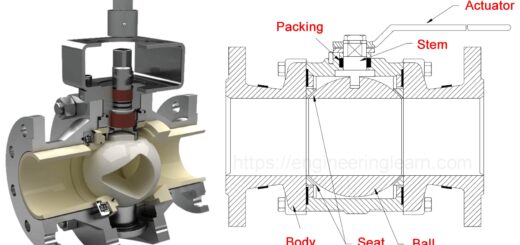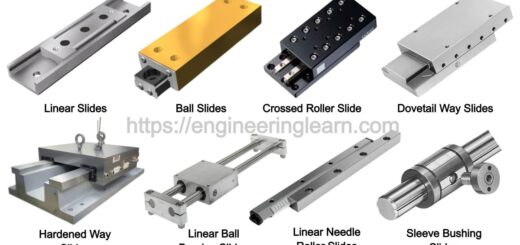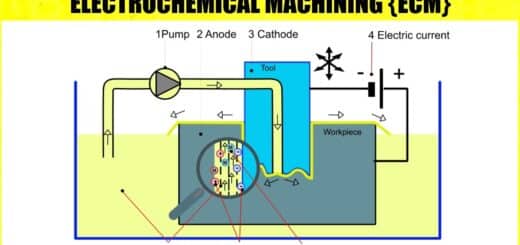Industrial Scrubbers – Types, Function, Material, Application, Advantages & Disadvantages [Complete Explained]
![Industrial Scrubbers - Types, Function, Material, Application, Advantages & Disadvantages [Complete Explained]](https://engineeringlearn.com/wp-content/uploads/2023/01/Industrial-Scrubbers-1024x539.jpg)
Industrial Scrubbers are pivotal pollution control devices that eliminate the hazardous particles from industrial fumes and gas streams before releasing them into the atmosphere. Scrubbers are designed equipment that involves liquid for eliminating particulate matter, solids, fog, and unsafe gases. The fluid in its atomized structure en-trains particles and toxin gases and successfully cleans out them from the gas stream. Industrial Scrubbers can likewise be used to recuperate valuable products preventing loss of product.
What is the Essential material in an Industrial Scrubbers?
An industrial scrubber framework typically integrates a system fan, recycle pump, instrumentation and controls, fog eliminators, and exhaust stack. A scrubber material should be corrosion resistant. The mechanical scrubber plan relies upon different parameters like:
- Operating process conditions
- Flow rate
- Temperature
- Concentration
- Removal efficiency
- The chemicals being removed, etc
Functions of Industrial Scrubbers
Various types of Industrial scrubbers help to safeguard the environment by dispensing hazardous chemicals and acids from polluted industrial exhaust gases. The main functions that industrial scrubbers serve are:
- They lessen the possibilities of acid rain by eliminating unsafe acid gases.
- Local cleansing.
- Fume abatement.
- Heat recovery from hot gases.
Products from Different Types of Industrial Scrubbers
However the products of scrubbers are risky and have side effects, they can be treated to receive make them a useful products. Generally speaking, the scrubber and downstream handling create a strong slurry that is separated from the filtered gas. The pollutant product is processed further to make them a valuable end product.
Gypsum extracted from scrubbers utilized in coal power plants is an example of a useful product. Organizations need to understand the byproducts of their scrubbers. They should be appropriately disposed of the unsafe waste. Recycling waste is a great option. This will save from hazardous waste disposal. Also, the byproduct will help in making money.
Types of Industrial Scrubbers
Depending on the functioning standards of industrial scrubbers, they are assembled into the accompanying three classes:
1. Wet Industrial Scrubbers
The wet industrial scrubber is one of the most fundamental types of industrial scrubbers. They utilize a wet substance (Mostly water) to eliminate harmful substances. The wet substance is embodied in a metallic or composite box or container. At the point when the contaminated or polluted gas is passed through the container, the water/wet substances absorb or dissolve the impurities.
Wet scrubbers are manufactured in numerous configurations. With an expansion in gas to liquid contact time inside the scrubber, the removal productivity increases. Additionally, expanding surface area and blending can work on the performance of wet industrial scrubbers.
Advantages of Wet Scrubber
- Versatile applications: Wet Industrial scrubbers can remove a host of contaminants, including both gases and particulate matter. Wet Industrial scrubbers are also a good choice for handling high-temperature, high-humidity gas streams, unlike ESPs and some other types of filtration systems.
- High collection efficiency: Wet Industrial scrubbers also have exceptionally high rates of collection efficiency. At the end of the day, they’re ready to actually eliminate pollutants practically completely, leaving almost no final exhaust stream.
- Compact size: Wet scrubbers are additionally smaller than some other scrubber system types. This makes them more convenient to retrofit into a current industrial facility. Smaller-sized machines can also mean lower initial costs.
Disadvantages of Wet Scrubbers
- Disposal complications: Wet scrubbers produce a concentrated slurry from the toxins they trap, and this emanating stream should be discarded appropriately. Nonhazardous slurries are for the most part straightforward to dispose of, however, poisonous effluent should be dealt with and disposed of by hazardous garbage disposal guidelines.
- Operating costs: Fixed or stationary wet scrubber frameworks have demanding horsepower and pressure-drop necessities. They may likewise require more maintenance than a few different systems since solids can collect the wet-dry point of interaction, and acidic slurries can be profoundly corrosive.
2. Electrostatic Precipitators or ESP’s
Electrostatic precipitators utilize charged energy to eliminate dust and different pollutants from a gas stream. They match the polarity and kind of charge to bind and eliminate the pollutants from the gas. ESP’s have a very high collection efficiency. Contingent upon the cleaning of the collective particles in collector plates, Electrostatic precipitators are of two types as mentioned below:-
- Dry ESP’s where the collected particles are removed from collector plates as dry material by mechanical impulse or vibration.
- Wet ESP’s where the collator plates are washed with water.
A plate precipitator is a regular illustration of a dry electrostatic precipitator. A sheet of metal is charged with a particular type of charge that runs parallel with the piping. At the point when the gas goes through the plates, the residue and other toxins are removed. Wet electrostatic precipitators help to eliminate high moisture gases like sulfuric acid.
Advantages of Electrostatic Precipitators
Electrostatic precipitators offer a few advantages over alternative innovations, including their:
- High collection efficiency: When it comes to particulate matter, ESP’s offer impressive collection efficiencies that can exceed 99%. Though they are limited to particulate matter, ESP’s are able to thoroughly collect a variety of contaminants, including corrosive, wet, and high-temperature materials.
- Large capacity: ESP’s can also handle extremely large gas flow rates and heavy dust loads with low-pressure losses. This makes ESP’s a good choice in facilities with high-volume exhaust streams that only need to be purified of particulate matter.
- Low operating costs: ESP’s tend to be fairly low-maintenance. Add to this that ESP’s don’t require any filtration media. The outcome is a framework that is somewhat cheap to operate. This additionally implies you don’t have to store any additional components nearby to operate your ESP.
Disadvantages of Electrostatic Precipitators
There are likewise a couple of reasons behind why a company may not pick an ESP to filter their exhaust streams. The ESP’s disadvantages include: –
- Large footprint: ESP’s take up a huge area, which makes it challenging to retrofit them into existing facilities. Once installed, moving the ESP to a new location or re-configuring it can be a challenge.
- Inability to filter gases: ESP’s can be an effective choice for filtering particulate matter like dust or soot, but these systems cannot be used to remove gaseous pollutants. This significantly limits the valuable applications of ESP’s since numerous industrial operations produce both gaseous and strong toxins that should be filtered.
3. Dry Industrial Scrubbers
A dry industrial scrubber comprises a reaction center with dry sorbent or reaction material to retain harmful foreign substances from the contaminated gas. There is a material component to eliminate the reaction product. Dry scrubbers are broadly used to eliminate acids found inside gasses. The sorbent is basic in nature and neutralizes by reacting with the acid present in the gas.
The working of dry industrial scrubbers is practically like wet scrubbers with the exception of that dry reagents are utilized. Despite the fact that Dry scrubbers are not quite so compelling as wet scrubbers, they are preferred in light of the fact that dry scrubbers make almost no loss when contrasted with wet scrubbers. At the same time, the problems of disposing of wet waste material are eliminated.
Advantages of Dry Scrubbers
Dry scrubbers have acquired prevalence because of some benefits they offer, including:
- Simpler waste disposal: If we compare Dry scrubbers with wet scrubbers, dry scrubbers offer more straightforward waste removal. Instead of taking care of wet muck, you just have to dispose of the dry particles collected. Heavier particles fall down to the lower part of the system and are caught in a particle screen, and different foreign substances are absorbed by the sorbent, which can without much of a stretch be taken out from the system.
- Lower maintenance: These frameworks will generally require less maintenance than wet scrubbers, keeping activity more straightforward with less downtime.
- Compact size: An advantage that wet and dry scrubbers have in common, compared to ESP’s, is that they’re both relatively compact. Since dry scrubbers have a minuscule impression, you can without much of a stretch track down the best spot to install them in your industrial facility.
Disadvantages of Dry Scrubbers
Dry scrubbers likewise accompany a few drawbacks, including their:
- Limited efficiency: Like wet scrubbers, dry scrubbers can trap both gaseous and particulate pollutants. Notwithstanding, dry scrubbers are known to be less effective than wet scrubbers, so they might permit more pollutants to escape into the environment.
- Need for reactants: Dry scrubbers require special reactants to operate. This implies you want to keep these reactants available consistently, adding to your storage needs. These reactants can likewise be generally costly, adding to the higher ongoing working costs.
Applications of Industrial Scrubbers
Industrial mechanical scrubbers can be utilized for various industrial processes including gases. Any industry with an elevated degree of air toxins or odors, or consuming petroleum products should install an appropriately designed scrubber framework. A few typical instances of the utilization of industrial scrubbers are:
- Acid Plants
- Chemical Industry
- Steel mills
- Large Power Plants
- Fertilizer plants
- Surface treatment
- Asphalt plants
- Pharmaceutical industry
- Waste incineration installations
- Storage and transfer of chemicals
Advantages of Industrial Scrubbers
- Effective prevention of pollutants.
- Handling of combustible and dangerous residue with little risk.
- providing gas retention and residue collection in a solitary unit.
- Cooling of hot gases.
- Compact design helps in retrofitting any current collection frameworks without requiring much space.
- Corrosive gases and dust are neutralized.
- Very low maintenance cost.
Disadvantages of Industrial Scrubbers
- High corrosion potential.
- Collected particulate material may be contaminated and unrecyclable.
- Freezing protection may be required.
- Waste sludge disposal may be expensive
Conclusion
A properly designed scrubber should be used in all industries with a high level of air toxins or odors, or burning fossil fuels. Industrial Scrubbers remove harmful and hazardous substances from industrial exhaust gases or flue gases. The efficiency of scrubbers depends on various factors. By utilizing an industrial scrubber that offers the right abilities, you can keep unsafe toxins from entering the atmosphere.
Content Source: – machengineering, whatispiping
Image Source: – saferack













